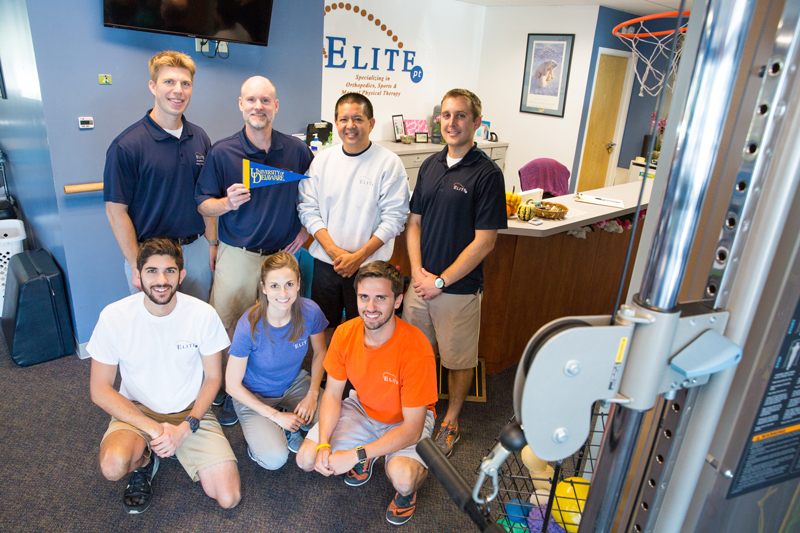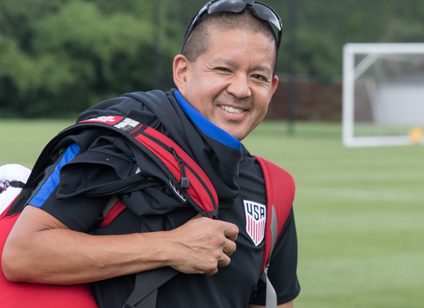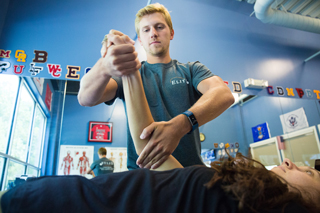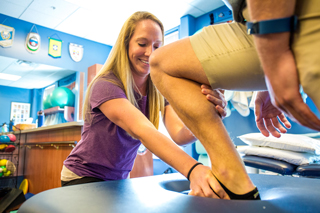


Elite PT
Photos by Ashley Barnas, Aaron Davis, and courtesy of Jim Hashimoto December 21, 2017
Blue Hen alumni provide physical therapy care at Elite PT
Elite PT was named to the Blue Hen 43 Fastest Growing Companies list at the 2017 Blue Hen 17&43 Awards. Run by University of Delaware alumni, the physical therapy company treats patients across the lifespan for all types of orthopedic, musculoskeletal, and neuromuscular injuries and disorders.
“Receiving the 17&43 Award was an honor, and wonderful recognition not only of our business success, but our commitment to the values and expectations that UD instilled in us,” said Elite PT partner Caroline Queale.
The 17&43 Awards honor promising new ventures and fast-growing companies founded, owned or led by University of Delaware students and alumni. Four of the company’s five partners — Queale ‘91 (master’s), Jim Hashimoto ‘91 (master’s), John Knarr, ‘80, and Andy Rudawsky, ‘90 (master’s) — are all graduates of the College of Health Sciences. Amelia Knarr, the business backbone of the company, is the fifth partner and a proudly "adopted" Blue Hen.

While studying physical therapy at UD, the future partners often joked about opening their own practice. Sure enough, that notion came to fruition nearly two decades later.
“When we started Elite PT, we wanted to create something different in the field,” Hashimoto said. “We wanted to be more manual therapy based, more preventative. But do it in a way that wouldn’t sacrifice quality.”
After nearly ten years of business, Elite PT has grown each year and now has five locations — Wilmington, Hockessin, Rehoboth Beach, Baltimore and Wayne, Pennsylvania. All of the partners still treat patients on a regular basis.
“Every patient gets manual therapy. That’s what we need to do as physical therapists,” Rudawsky said. “We don’t want to be glorified personal trainers and watch patients do exercises that they can do at home. There’s much more to physical therapy than that.”

The partners are extremely complimentary of the University of Delaware, which is evidenced in their hiring practices. More than 90 percent of Elite PT staff members are Blue Hen graduates.
“What drew me to Elite PT was the focus on patient-centered care,” said Chris Vodzak, a 2016 UD doctorate of physical therapy graduate and current Elite PT physical therapist. “You won't find many outpatient clinics where the physical therapists spend as much one-on-one time with patients.”
Rudawsky added, “The students coming out of UD have such an edge educationally. They are phenomenal to work with. There is something that students get from the program that gives them a step up in treating patients. Chris is one of our most recent hires; he stepped in like he had already been out of school for a few years.”
Soccer savants
With two European parents, Rudawsky inherited a love of soccer and, as a player, jokingly ‘donated’ his knees to the sport. Once he was exposed to the athletic training world behind the sport, he was hooked, going on to earn athletic training and physical therapy degrees.

“Back when I was working for a hospital system, every physician wanted to be a part of the main sports — football, baseball and basketball,” Rudawsky said. “To them, players in these other sports were not athletes. I was thinking, ‘You don’t want them? I’ll take them!’ So I did all of the other sports, including soccer. Since then, they’ve changed their tune big-time.”
In 1991, that love led Rudawsky all the way to the U.S. Men’s National Team, where he served as head athletic trainer/physical therapist for a decade. But he made sure he wasn’t the only Blue Hen, calling up Hashimoto to join him. After working under Rudawsky, Hashimoto is currently on his second stint as the head man.
The pair have practiced their craft all over the world at major tournaments, including seven FIFA World Cups between them. Unlike major U.S. professional sports leagues, international soccer lacks a neat and tidy season. The schedule is extremely spread out. National team players get permission to leave their clubs for international qualifying games and tournaments — essentially playing on two teams at once. Tracking the health and injury rehabilitation progress of players spread across club teams in Europe and North America is a steep challenge. The sports medicine team must perform everyday medical care when the team is on the road. But they must also communicate with dozens of club teams about players’ fitness levels and injuries.
“We’re always developing relationships with club teams’ sports medicine staff so that health information flows willingly and without hesitation,” Hashimoto said. “A lot of this is private information. The club team doesn’t want it out there. But we’re all healthcare professionals. This is about the individual athlete — transitioning him between two different environments to allow both club and country to benefit.”
And it’s not just the players currently on the matchday roster who must be assessed. It’s the team’s entire player pool.
“On the injury side, I facilitate the players getting what they need — whether it’s setting them up with specialists all over the world or visiting me to do rehab [in Delaware],” said Hashimoto. “On the fitness side, that is a continually evolving area. Sports medicine and sports science are working together to be predictive on training loads so we can enhance athletic performance and reduce the risk of injury.”
The pair’s dedication to the sport is evident, but, at the youth level, they warn against over-training in a single sport.
“With club situations and tournaments, it’s gotten to the point where many kids are playing too much,” Rudawsky said. “You absolutely see overuse injuries from one sport. I believe in cross-training in different sports. It’s what I personally did. It’s what my wife and I do with our kids.”
Contact Us
Have a UDaily story idea?
Contact us at ocm@udel.edu
Members of the press
Contact us at 302-831-NEWS or visit the Media Relations website

